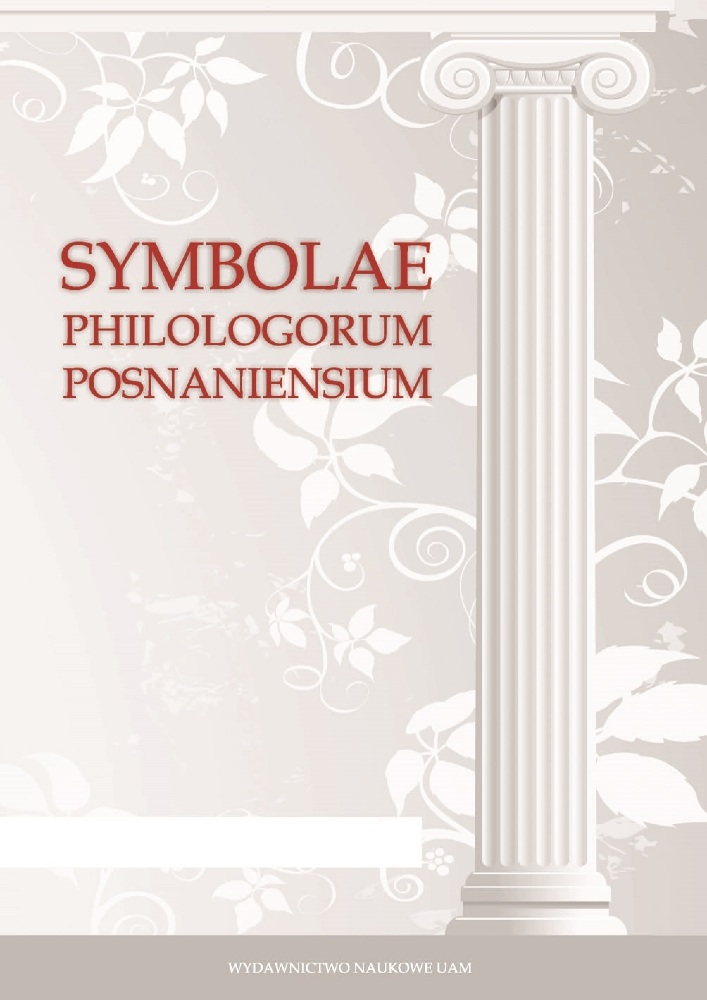Abstrakt
The passage from the Terentian comedy Phormio, v. 778–782, contains few interesting expressions, which are described in the article. First of all this short commentary examines the meaning of the Latin noun versura, attested in line no. 780. Versura is used in Phormio in a phrase vosuram solvere, which may mean to solve the loan agreement or to pay off the loan. Other phrases in the presented passage create a context for our analysed noun, especially: in eodem luto haesitas – you are getting stuck in the same mud. This proverbial expression emphasizes repetition of the situation and has probably the same iterative meaning as versuram solvere. Therefore we may assume, that versuram solvere means in the play: borrowing money on interest to pay a previous debt. The whole image of repeated problems is being summarized by the character of the play saying: plagae crescunt – the number of lashes increases. This expression is to show the gradation of the troublesand it proves, that also versura must include some kind of gradation, i. e. the growth of interest. The article shows phraseology, which is employed to depict slave’s action – proverbial and legal expressions are used to build a metaphor in the character’s utterance. This metaphor is built by all of the mentioned expressions in eodem luto haesitas, vorsuram solves, plagae crescunt. The first two expressions start the figure called climax and plagae crescunt summarizes this stylistic device. Moreover this whole image has been used by Terence to demonstrate the progress of the complex plot in the play – the slave has already carried on two intrigues and to avoid the consequences of his actions he might make the third fraud.Bibliografia
Publii Terentii Afri Comoediae, ed. R. Bentleius, Cantabrigiae 1726.
P. Terentii Carthaginiensis Afri, Comoediae sex, t. 2, rec. F. Lindenbrog, Londini 1820.
Ausgewählte Komödien des P. Terentius Afer, hrsg. K. Dziatzko, Leipzig 1898.
P. Terentii Phormio, H.C. Elmer, Boston 1902.
Terence, Phormio, ed. R.H. Martin, London 1959.
Terence, Phormio, ed. E.M. Coury, Chicago 19842.
Allen W.F., The Monetary Crisis in Rome, A.D. 33, „TAPhA” 18, 1887, s. 5–18.
Bekker E.I., Über die Objekte und die Kraft der chuldverhältnisse: geschichtliche Überschau, von der Zeit der Manusinjektion bis in die Gegenwart, „ZSS” 23, 1902, s. 1–30.
Dougan T.W., M. Tulli Ciceronis Tusculanarum disputationum libri quinque, vol. I i II, Salem, New Hampshire 1905.
Fantham E., Comparative Studies in Republican Latin Imagery, Toronto 1972.
Johnston D.E.L., Review of: K. Wille, Die Versur: Eine Rechtshistorische Abhandlung Über die Zinskapitalisierung im Alten Rom, „JRS 77”, 1987, s. 204.
Just R., Women in Athenian Law and Life, New York 1991.
Köstermann E., Cornelius Tacitus. Annalen, Bd. 2: Buch 4–6, Heidelberg 1965.
Maltby R., The Distribution of Imagery by Plays and Characters in Terence, „Zetemata” 127, 2007, s. 143–165.
Niebuhr B.G., Römische Geschichte, Bd. I, Berlin 1828.
Otto A., Die Sprichwőrter und Sprichwőrtlichen Redensarten der Rőmer, Leipzig 1890.
Pieczonka J., Tradycyjne powiedzenie „par pari respondere” jako fragment codziennego dyskursu w komedii rzymskiej, „Classica Wratislaviensia”, XXVIII, 2008, s. 189–202.
Pikulska A., Anatocisme. C. 4,32,28,1: Usuras semper usuras manere, „RIDA” 45, 1998, s. 429–449.
Pikulska-Robaszkiewicz A., Lichwa w państwie i prawie republikańskiego Rzymu, Łódź 1999.
Skiles J.W.D., The Commercial Vocabulary of Early Latin as shown in the Comedies of Plautus, „CJ” 36, 9, 1940–1941, s. 519–536.
Skwara E. (tłum.), Terencjusz, Komedie, tom II, Warszawa 2006.
Szpila G., Krótko o przysłowiu, Kraków 2003.
Thomas P.J., Did the Twelve Tables limit interest?, „TSAR”, 2008 (1), s. 52–65.
Tilli G., Postremo vetita versura, „BIDR” 86–87, 1984, s. 147–163.
Visser A.S.Q., Joannes Sambucus And The Learned Image: The Use Of The Emblem In Late-renaissance Humanism, Leiden 2005.
Wille K., Die Versur: Eine Rechtshistorische Abhandlung Über die Zinskapitalisierung im Alten Rom (Schriften zur Rechtsgeschichte XXXIII), Berlin 1984.
Licencja
